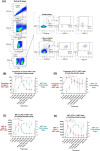The effect of blocking immune checkpoints LAG-3 and PD-1 on human invariant Natural Killer T cell function
- PMID: 37344517
- PMCID: PMC10284876
- DOI: 10.1038/s41598-023-36468-8
The effect of blocking immune checkpoints LAG-3 and PD-1 on human invariant Natural Killer T cell function
Abstract
Invariant Natural Killer T (iNKT) cells undergo immune exhaustion during chronic activation caused by cancer and viral infections, such as HIV. Exhaustion is marked by cell dysfunction and increased expression of immune checkpoint proteins programmed cell-death-1 (PD-1) and lymphocyte-activation-gene-3 (LAG-3). We hypothesize that blockade of PD-1 and/or LAG-3 will enhance iNKT cell function. Utilizing peripheral blood mononuclear cells from healthy donors, LAG-3 and PD-1 expression on iNKT cells was assessed using flow cytometry following in vitro stimulation with iNKT-specific stimulant α-galactosylceramide (n = 4). Efficacy of anti-LAG-3 and/or anti-PD-1 antibody blockades in enhancing iNKT cell function was assessed by determining proliferative capacity and IFN-γ production (n = 9). LAG-3 and PD-1 expression on iNKT cells peaked at Day 4 (98.8%; p ≤ 0.0001 and 98.8%; p = 0.005, respectively), followed by steep decrease by Day 10, coinciding with peak iNKT cell proliferation. In a 10-day blocking assay, both the anti-PD-1 alone and dual anti-PD-1 and anti-LAG-3 significantly increased iNKT proliferation (6 and 6.29 log2 fold-change respectively) compared to the no blockade control (ANOVA-p = 0.0005) with the dual blockade system being more effective (t-test-p = 0.013). This provides proof-of-concept for LAG-3 and PD-1 as immunotherapeutic targets to enhance human iNKT cell function, with the long-term goal of addressing immune exhaustion.
© 2023. The Author(s).
Conflict of interest statement
The authors declare no competing interests.
Figures




Similar articles
-
Roles of the programmed cell death 1, T cell immunoglobulin mucin-3, and cluster of differentiation 288 pathways in the low reactivity of invariant natural killer T cells after chronic hepatitis B virus infection.Arch Virol. 2015 Oct;160(10):2535-45. doi: 10.1007/s00705-015-2539-3. Epub 2015 Jul 29. Arch Virol. 2015. PMID: 26215444
-
Elevated expression of LAG-3, but not PD-1, is associated with impaired iNKT cytokine production during chronic HIV-1 infection and treatment.Retrovirology. 2015 Feb 13;12:17. doi: 10.1186/s12977-015-0142-z. Retrovirology. 2015. PMID: 25810006 Free PMC article.
-
Natural Killer T-Cell Agonist α-Galactosylceramide and PD-1 Blockade Synergize to Reduce Tumor Development in a Preclinical Model of Colon Cancer.Front Immunol. 2020 Oct 20;11:581301. doi: 10.3389/fimmu.2020.581301. eCollection 2020. Front Immunol. 2020. PMID: 33193386 Free PMC article.
-
Hiding lipid presentation: viral interference with CD1d-restricted invariant natural killer T (iNKT) cell activation.Viruses. 2012 Oct 23;4(10):2379-99. doi: 10.3390/v4102379. Viruses. 2012. PMID: 23202469 Free PMC article. Review.
-
Invariant natural killer T cells: innate-like T cells with potent immunomodulatory activities.Tissue Antigens. 2009 Jun;73(6):535-45. doi: 10.1111/j.1399-0039.2009.01256.x. Epub 2009 Apr 8. Tissue Antigens. 2009. PMID: 19392798 Review.
Cited by
-
Engineering an in vivo charging station for CAR-redirected invariant natural killer T cells to enhance cancer therapy.Res Sq [Preprint]. 2025 Apr 10:rs.3.rs-6215345. doi: 10.21203/rs.3.rs-6215345/v1. Res Sq. 2025. PMID: 40297706 Free PMC article. Preprint.
-
Mycobacterium tuberculosis Modulates the Expansion of Terminally Exhausted CD4+ and CD8+ T-Cells in Individuals with HIV-TB Co-Infection.Pathogens. 2025 Aug 11;14(8):802. doi: 10.3390/pathogens14080802. Pathogens. 2025. PMID: 40872312 Free PMC article.
-
The CML experience to elucidate the role of innate T-cells as effectors in the control of residual cancer cells and as potential targets for cancer therapy.Front Immunol. 2024 Nov 15;15:1473139. doi: 10.3389/fimmu.2024.1473139. eCollection 2024. Front Immunol. 2024. PMID: 39620210 Free PMC article.
-
Mucosal T-cell responses to chronic viral infections: Implications for vaccine design.Cell Mol Immunol. 2024 Sep;21(9):982-998. doi: 10.1038/s41423-024-01140-2. Epub 2024 Mar 8. Cell Mol Immunol. 2024. PMID: 38459243 Free PMC article. Review.
-
The tetravalent, bispecific properties of FS118, an anti-LAG-3/PD-L1 antibody, mediate LAG-3 shedding from CD4 + and CD8 + tumor-infiltrating lymphocytes.Anticancer Drugs. 2025 Jul 1;36(6):447-458. doi: 10.1097/CAD.0000000000001705. Epub 2025 Mar 3. Anticancer Drugs. 2025. PMID: 39960386 Free PMC article.
References
Publication types
MeSH terms
Substances
Grants and funding
LinkOut - more resources
Full Text Sources

